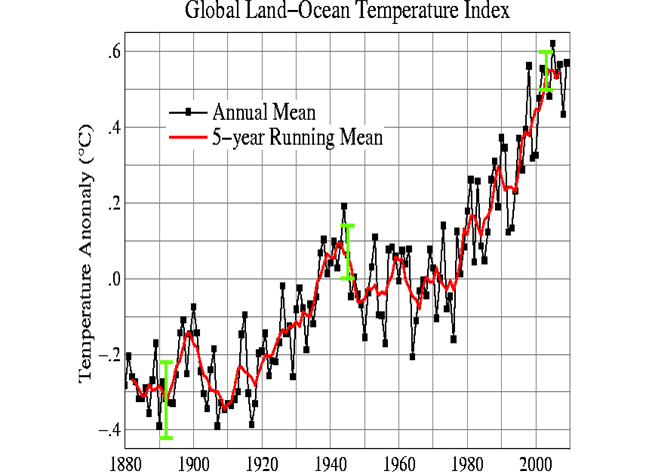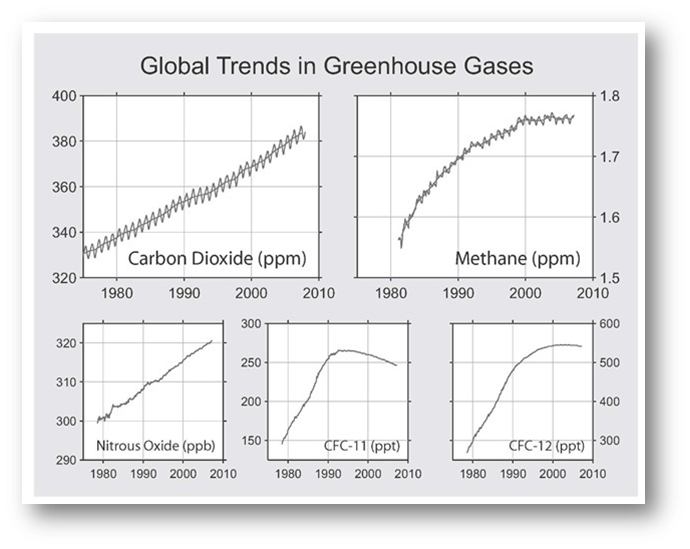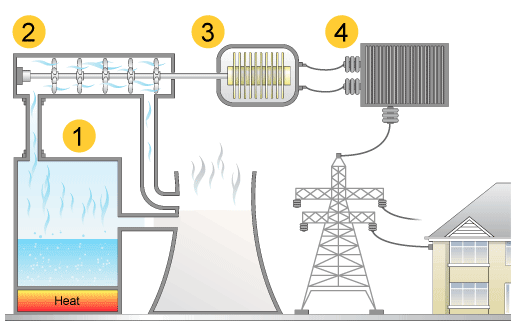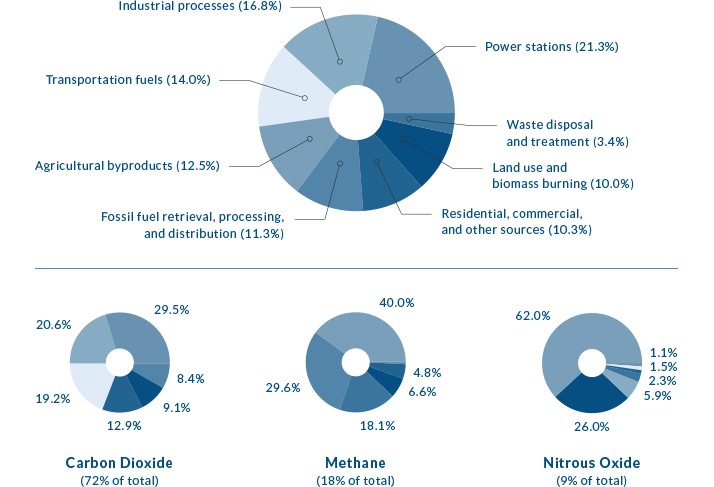Chapter 5.3 / Anthropogenic Contributors to Climate Change
Anthropogenic Contributors to Climate Change
This section describes some of the most common anthropogenic (human) sources of greenhouse gases.
Professional Development for Educators
Anthropogenic Contributors to Climate Change
Since the start of the Industrial Revolution, humans have engaged in a range of behaviors (e.g., burning fossil fuels as an energy source and deforestation) that have increased the release of carbon dioxide into the atmosphere. Scientific consensus is that these behaviors are interrupting the carbon cycle and contributing to long-term increases in the amount of greenhouse gases in the atmosphere.
We are releasing carbon from ancient carbon stores so quickly that the natural processes in place to capture and store it cannot keep up with the release. As a result, there is an imbalance in carbon dioxide levels in the Earth's spheres. This imbalance of CO2 levels is mostly in the atmosphere and hydrosphere.
Additionally, as we cut down large sections of forest we are removing one of the major processes in the carbon cycle designed to remove CO2 from the atmosphere (through the photosynthesis of the trees).

Source: sedgemore.com/2010/10/consolidating-the-climate-change-record/
The graphic above is popularly known as the “hockey stick” graph of global temperature change over the past 1000 years. The figure clearly illustrates the drastic nature of recent climate change and the rapid change in mean global temperatures since the mid-1800s.
Recent Climate Trends

Source: http://data.giss.nasa.gov/gistemp/graphs_v3/
This graphic shows the annual mean global temperatures since 1880.
There are many different factors – some natural and some not – contributing towards global climate change. However, the scientific community widely agrees that, "Human influence on the climate system is clear, and recent anthropogenic emissions of greenhouse gases are the highest in history. Recent climate changes have had widespread impacts on human and natural systems."
Source: IPCC, 2014: Climate Change 2014: Synthesis Report. Contribution of Working Groups I, II and III to the Fifth Assessment Report of the Intergovernmental Panel on Climate Change [Core Writing Team, R.K. Pachauri and L.A. Meyer (eds.)]. IPCC, Geneva, Switzerland, p 2
Scientific consensus is clear that by altering the composition of the atmosphere humans are increasing the average temperature of the Earth’s surface.
Recent Greenhouse Gas Trends

Source: http://www.globalwarmingart.com/wiki/File:Major_greenhouse_gas_trends_png
The rise of GHGs are believed to be responsible for most of the increase in global average temperatures during the last 50 years.
At present, approximately 99 percent of the 100-year global warming potential for all new emissions can be ascribed to just these three gases: carbon dioxide, methane, and nitrous oxide.
Intergovernmental Panel on Climate Change
According to the IPCC Fourth Assessment Report: Climate Change 2007:
“Warming of the climate system is unequivocal, as is now evident from observations of increases in global average air and ocean temperatures, widespread melting of snow and ice, and rising global average sea level.” https://www.ipcc.ch/publications_and_data/ar4/syr/en/spms1.html
“Most of the observed increase in global average temperatures since the mid-20th century is very likely* due to the observed increase in anthropogenic greenhouse gas concentrations.” https://www.ipcc.ch/publications_and_data/ar4/wg1/en/spmsspm-understanding-and.html#footnote12
*IPCC defines ‘very likely’ as greater than 90 percent probability of occurrence.
Ninety-seven percent of climate scientists agree that climate-warming trends over the past century are very likely due to human activities, and most of the leading scientific organizations worldwide have issued public statements endorsing this position.
So what are humans doing to induce climate change?
The combination of exploding population, economic growth and 150 years of industry based on fossil fuels has brought about our rapidly warming climate.
A massive amount of carbon has been sequestered or stored underground, in many forms including coal, oil, and natural gas, which we are now burning for transportation, power generation, and industrial process.
Millions of years ago decaying organic matter was buried by sediments and in the heat and pressure underground became coal, oil, and natural gas.
When these materials are burned for energy, it releases the sequestered carbon and throws Earth’s carbon cycle out of balance.
Electricity Generation
Many students are unaware of the relationship between electricity generation and carbon dioxide production. This section provides an overview.

Electrical generation and distribution of electricity to consumers most commonly includes the components in this diagram.
- Steam Generation (water boiled using coal or other sources of energy)
- Turbine (steam causes the turbine to spin which translates into mechanical, or kinetic, energy transferred to the generator)
- Electromechanical Generator (transforms kinetic energy into electricity)
- Transformer (reduces electricity wattage for use by consumers)
Electrical Energy Sources
US Electricity Generation by Fuel Type

There are many different ways to heat water to create steam to produce electricity. The chart above show the sources of energy used in the United States to produce electricity. Coal is the most common energy source used to generate electricity in the United States.
Globally, more than 40% of all carbon dioxide emissions come from burning coal.
Greenhouse Gas Emissions by Sector

Source for this grahic and the preceeding graphic: http://www.globalwarmingart.com/wiki/File:Greenhouse_Gas_by_Sector_png
In the Classroom
Anthropogenic Contributors to Climate Change
Anthropogenic Contributors to Climate Change - 5.3 - PowerPoint PresentationMore Information and Resources
Anthropogenic Contributors to Climate Change
- This link is to a report by the International Energy Agency on Energy and Climate Change https://www.iea.org/publications/freepublications/publication/WEO2015SpecialReportonEnergyandClimateChange.pdf
- Pacific Institute for Climate Solutions Human Influence (4:08 minutes) http://www.youtube.com/watch?v=-GDY3dCqWQU&feature=youtu.be
- Pacific Institute for Climate Solutions What YOU Can Do About Climate Change (8:59 minutes) http://www.youtube.com/watch?v=VTfgNFz1DBM
- 100 Views of Climate Change, Colorado State University http://changingclimates.colostate.edu/
- Science Clarified Chapter 1 The Development of Energy http://www.scienceclarified.com/scitech/Energy-Alternatives/The-Development-of-Energy.html
- An overview of energy storage and transfer with information about energy sources http://www.bbc.co.uk/bitesize/ks3/science/energy_electricity_forces/energy_transfer_storage/revision/8/
- A slide show on energy generation from multiple sources http://www.slideshare.net/TejKiran2/energy-resources-types-35381452
